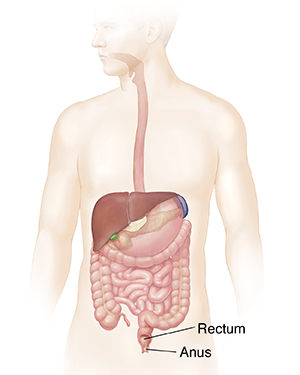Proctoscopy
Proctoscopy is a test that looks inside your rectum and anus. The rectum is the last part of the large intestine (colon). The anus is the opening of the rectum that leads out of the body. The test is done using a small lighted tube called a proctoscope. It can help find the cause of pain or bleeding. It can also be used to check for hemorrhoids or other rectal problems.

Getting ready for your test
Ask your healthcare provider any questions you may have about the procedure. Some of these may include:
-
Why do I need this procedure?
-
How many times have you done this procedure?
-
When will I get the results?
-
What are the possible complications?
After your questions are answered to your satisfaction, follow any directions from your healthcare provider.
Tell your healthcare provider about any medicines you are taking. This includes:
-
All prescription medicines
-
Over-the-counter medicines, such as aspirin or ibuprofen
-
Illegal drugs
-
Herbs, vitamins, and other supplements
You may need to stop taking all or some of these before the test. Follow any directions you’re given for not eating or drinking before the procedure.
You may be asked to use an enema or mild laxative before the exam. This is to clean out your rectum. Follow your healthcare provider's instructions carefully. Don't use an enema or laxative unless you are told to do so.
The day of your test
Before the test, you will be asked to sign a document called an Informed Consent Form. This form will have information on the procedure. It will list the risks and benefits of this test, and of the alternatives to the procedure. You will have a chance to ask questions before you sign the form. Be sure all of your questions are answered to your satisfaction before you sign and agree to the procedure.
The procedure takes about 10 minutes. You will go home the same day. Anesthesia is not often needed.
During the procedure:
-
You will lie on your left side with your knees bent. Or you’ll rest with your knees under your chest.
-
Your healthcare provider checks your rectum using a gloved, greased (lubricated) finger. They look for sore spots or blockages.
-
The lubricated proctoscope is carefully placed into your anus. It’s normal to have some cramping or feel the urge to have a bowel movement. In some cases, the healthcare provider may take 1 or more tissue samples (biopsies). This is done using tiny tools passed into the rectum through the proctoscope.
-
When the test is done, the proctoscope is removed.
-
You may be told the results of your exam right away. If a biopsy was taken, it will be tested in a lab. It may take anywhere from a few days to a week to get the results.
After the procedure:
You can drive yourself home and go back to your normal routine right away.
Recovering at home
Once home, follow any instructions you have been given. You may have mild bleeding with your first few bowel movements. This often happens if you had a biopsy. This is normal.
When to call the healthcare provider
Call your healthcare provider if you have any of the following:
-
Fever of 100.4° F ( 38° C) or higher, or as directed by your healthcare provider
-
A large amount of blood in the stool or bleeding that lasts more than a few days
-
Severe belly pain or a hard, swollen belly
Follow-up
You’ll talk about the test results with your healthcare provider before you go home. If a biopsy was taken, it will be tested in a lab. It may take a few days to a week to get the results. Based on the results of your exam and any biopsy, your provider may advise further tests or treatment.
Possible risks and complications
All procedures have some risk. Possible risks of proctoscopy include:
-
Infection
-
Bleeding from the rectum (but some light bleeding after the procedure is normal)
-
Mild belly pain during and after the test
-
In rare cases, a tear (perforation) in the rectum